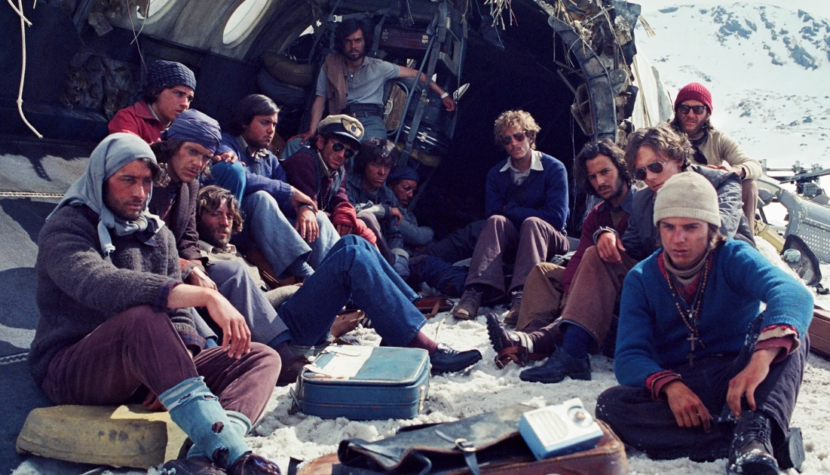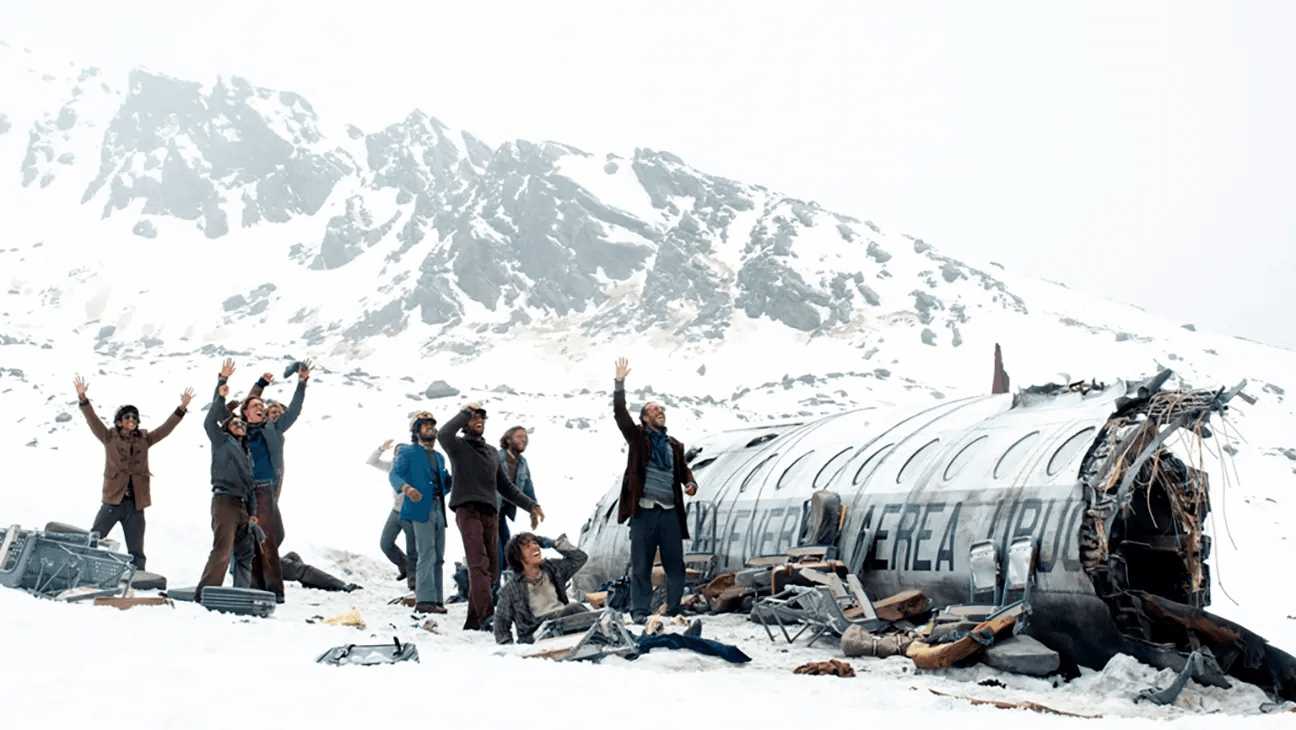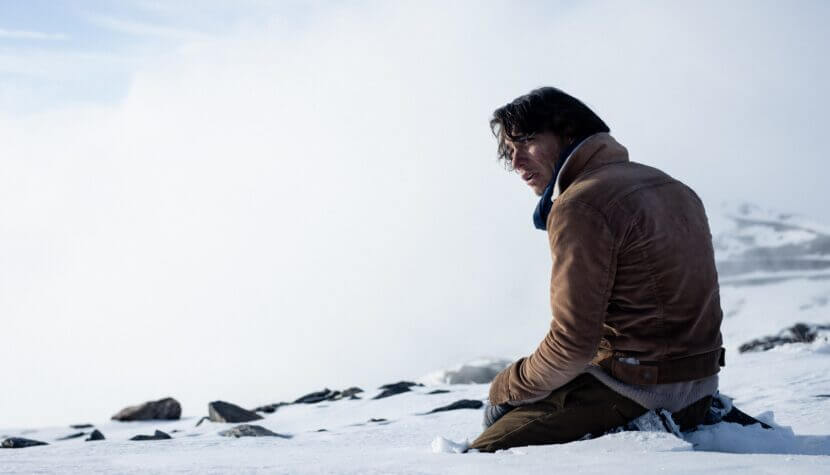SOCIETY OF THE SNOW. Alive and dead, all together

In Society of the Snow, an adaptation of Pablo Vierci’s book of the same title, we are transported to real events on (Friday!) October 13, 1972, and the 72 days that followed. From the very beginning, we become not only witnesses but active participants in the plane crash and subsequent humanitarian disasters. It all unfolds when the Uruguayan Air Force 571 plane, carrying a rugby team, crashes on the Argentine side of the Andes mountains, a few hundred meters from the Chilean border.
Just minutes before the impending tragedy, during what seemed like an ordinary flight, the future heroes pass the time with conversations and innocent antics with their families and friends. Most of them are in their twenties but still carry a lot of the carefree spirit of young boys—nothing can prepare them for unexpectedly having to relinquish that innocence.
The scene following the beginning of the film’s disaster is shot in a highly realistic manner. The camera remains close to the characters throughout, uncomfortably close to the point where every expanded pore on their faces seems visible on the screen. It’s easy to feel as if we are sitting among them, providing a perspective that is both terrifying and undoubtedly chilling. Whether alive or deceased, we will stick together until the end, whether we want to or not.
Society of the Snow is a film about the power of human determination and the will to survive. Most of the 16 out of 40 survivors of the crash were devout Christians, and what they had to do to survive was seen as a sin they could never forgive themselves for. Trapped at an altitude of 3,600 meters without water and food, in temperatures reaching minus forty degrees Celsius, they realize that the only thing they have is their life, and to survive, they must eat.
Now, someone might say, “We already had a movie about this disaster: ‘Alive,’ the Andes plane crash drama from 1993,” directed by Frank Marshall (producer of titles like ‘The Sixth Sense’ and the ‘Back to the Future’ trilogy), and starring Ethan Hawke! Are there no other, less-known plane crashes with potential for a narrative film covered in the 23 seasons of ‘Air Crash Investigation’?
According to Pedro Luque, the cinematographer from Uruguay, who spoke during the 31st EnergaCAMERIMAGE Film Festival, where I had the opportunity to watch Society of the Snow pre-premiere on the big screen and engage in a conversation with the creators, the 1993 film, despite its cinematic correctness, didn’t resonate well in Uruguay. Firstly, the casting of American actors speaking English took away the national identity of the survivors in the eyes of Uruguayans. Secondly, due to legal complications, only some of the ‘Alive’ characters use their real names, making it particularly hurtful in honoring the fallen. Thirdly, the Fuerza Aérea Uruguaya 571 plane crash is one of the significant events in the country’s history, and there was a societal need to tell the story from a subjective, native perspective.
The best response to whether it was worth making a new film on this topic is what happened during the special pre-premiere screening of Society of the Snow for the survivors and their families. Eduardo Strauch and Marcelo Pérez were best friends from childhood. The former survived, while the latter sadly passed away. Marcelo’s devastated mother couldn’t forgive Eduardo for surviving at the cost of her son’s life. Although Eduardo was a frequent visitor to her home before the catastrophe, after the events, he received a categorical ban. However, after watching Society of the Snow at the special screening, the grieving mother approached Eduardo with tears in her eyes, hugged him, and said that even though Marcelo didn’t survive, she’s glad he could help save other people’s lives.
It’s worth mentioning Pedro Luque’s personal connection to the national disaster of 1972—he openly admits that his wife is friends with the daughter of one of the survivors. Therefore, the memory of the ill-fated Fuerza Aérea Uruguaya 571 flight remains more vivid in her consciousness than in the average Uruguayan’s. Whether it’s because of this personal connection or not, the film remains close to the characters throughout, adding another interesting layer to the interpretive context of Society of the Snow.

Despite being emotionally engaging, the film is not without flaws. It’s glaringly obvious that it was produced by Netflix. Most of the most drastic events happen off-screen. Some real-life events are smoothed over or completely omitted. There are also common film absurdities, such as the lack of visible breath from characters breathing in freezing temperatures. Particularly noteworthy are the seemingly endless supplies of cigarettes, surpassing the availability of water and food, smoked by the survivors in impressive quantities.
As befitting a film about people who, through their extraordinary physical and mental resilience, had to endure hell on earth, Society of the Snow is filled with pathos that, at times, seems excessive. In a story based on such obvious and real drama, the sentimental, retrospective touches appear entirely unnecessary, and the music, while adding cinematic quality, sometimes distracts from the brutality conveyed by Pedro Luque’s cold, naturalistic shots.
Nevertheless, despite some shortcomings, Society of the Snow is an immersive, well-executed, and heart-wrenching film. If it receives an Academy Award nomination for Best International Feature Film, it wouldn’t be entirely undeserved. However, what seems most important in the context of its creation and the worldwide distribution provided by Netflix is that it undeniably pays tribute to the victims of the disaster. With each death on screen, the name, surname, and age of the fallen person appear. “Heroism is not just those who endured to the end but also those who made it possible.” And those who made it possible regain their identity in Snow Brotherhood.

